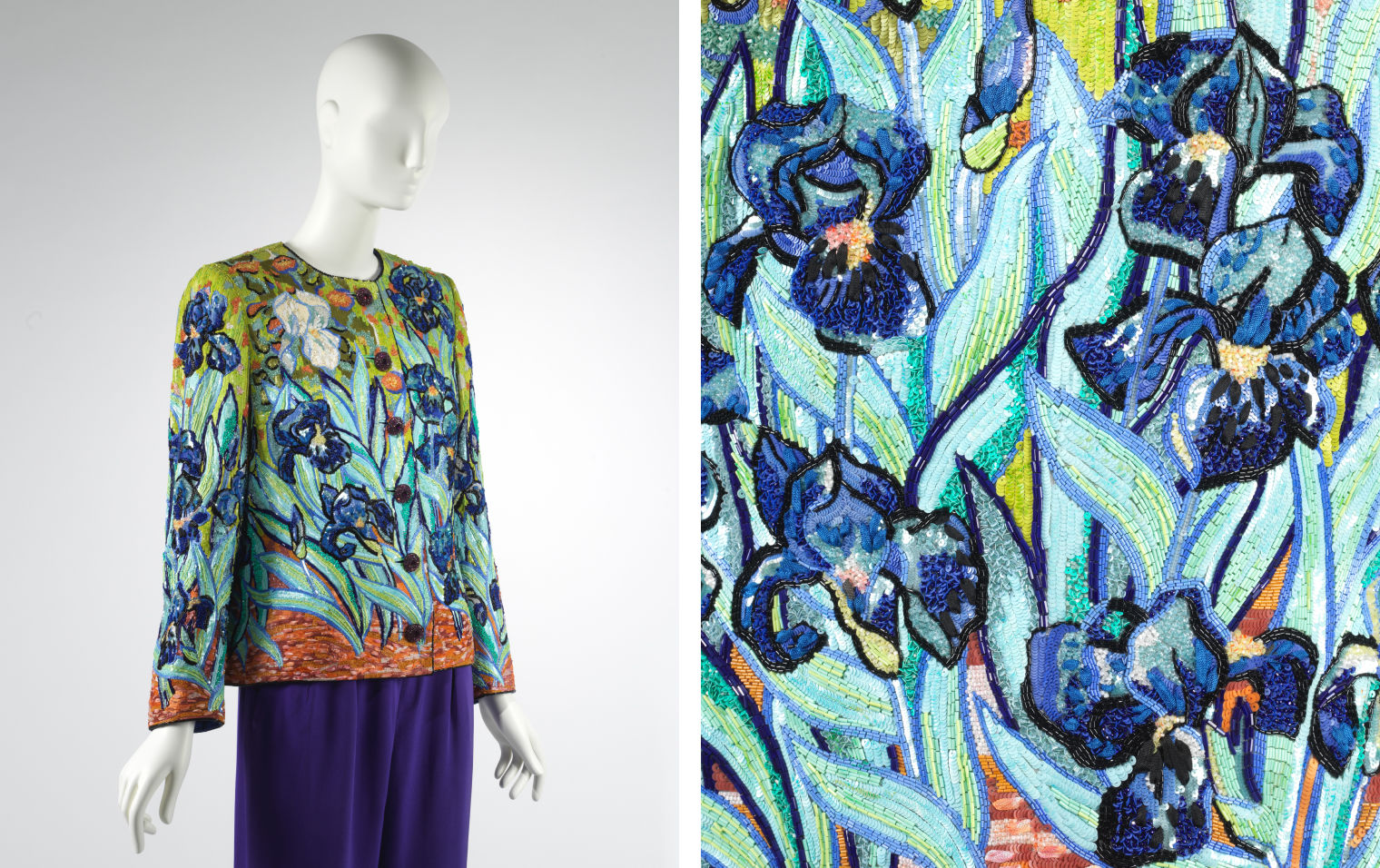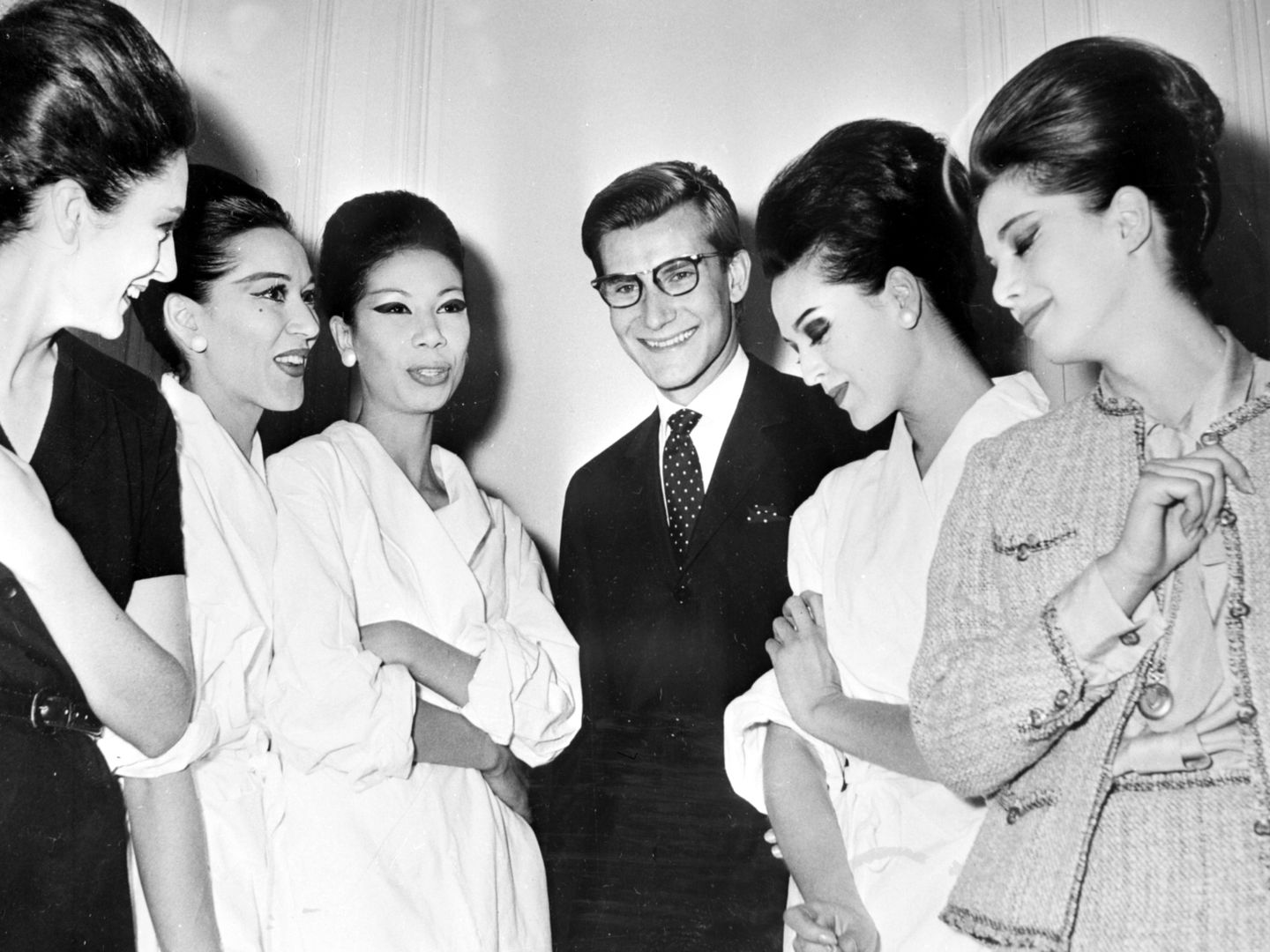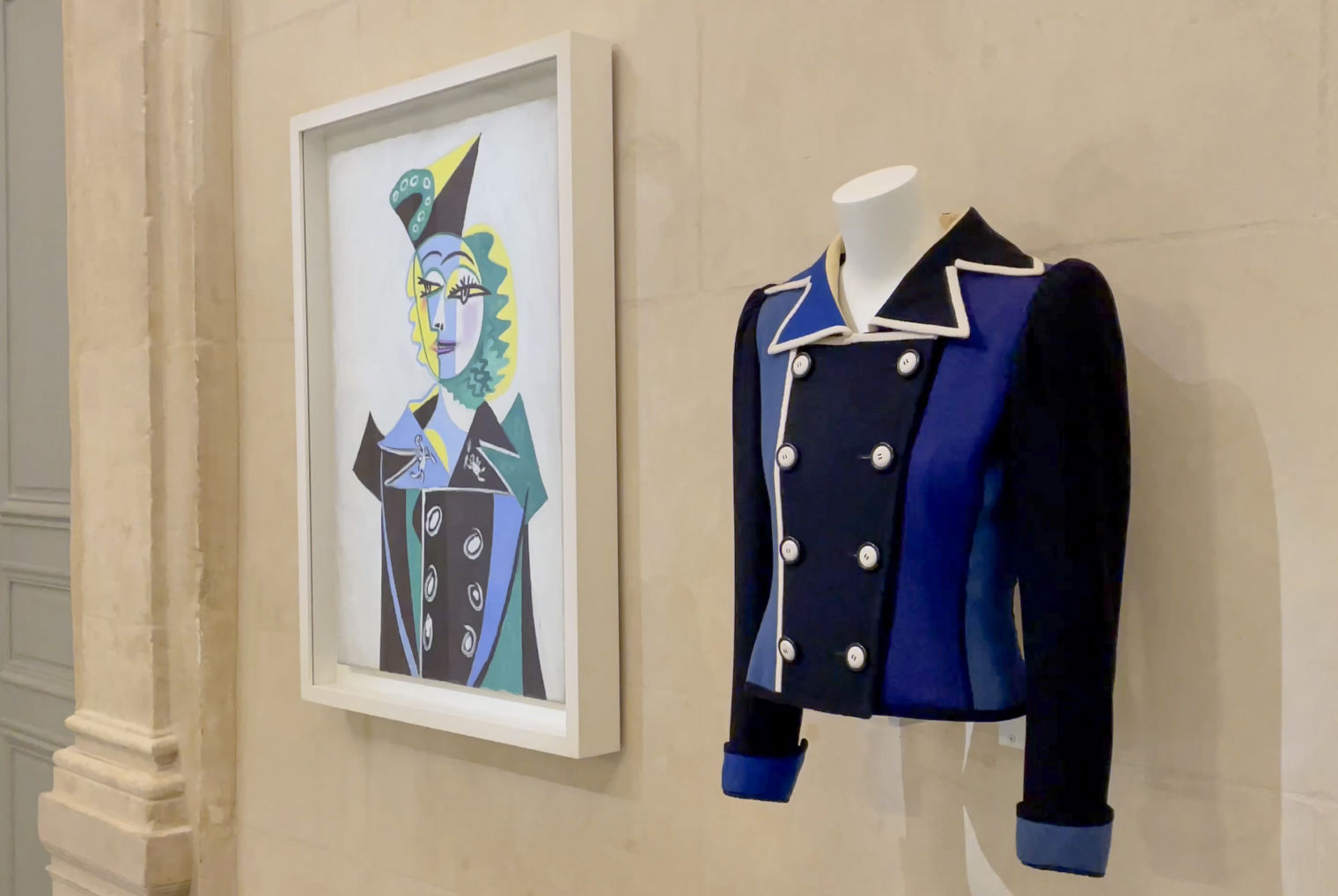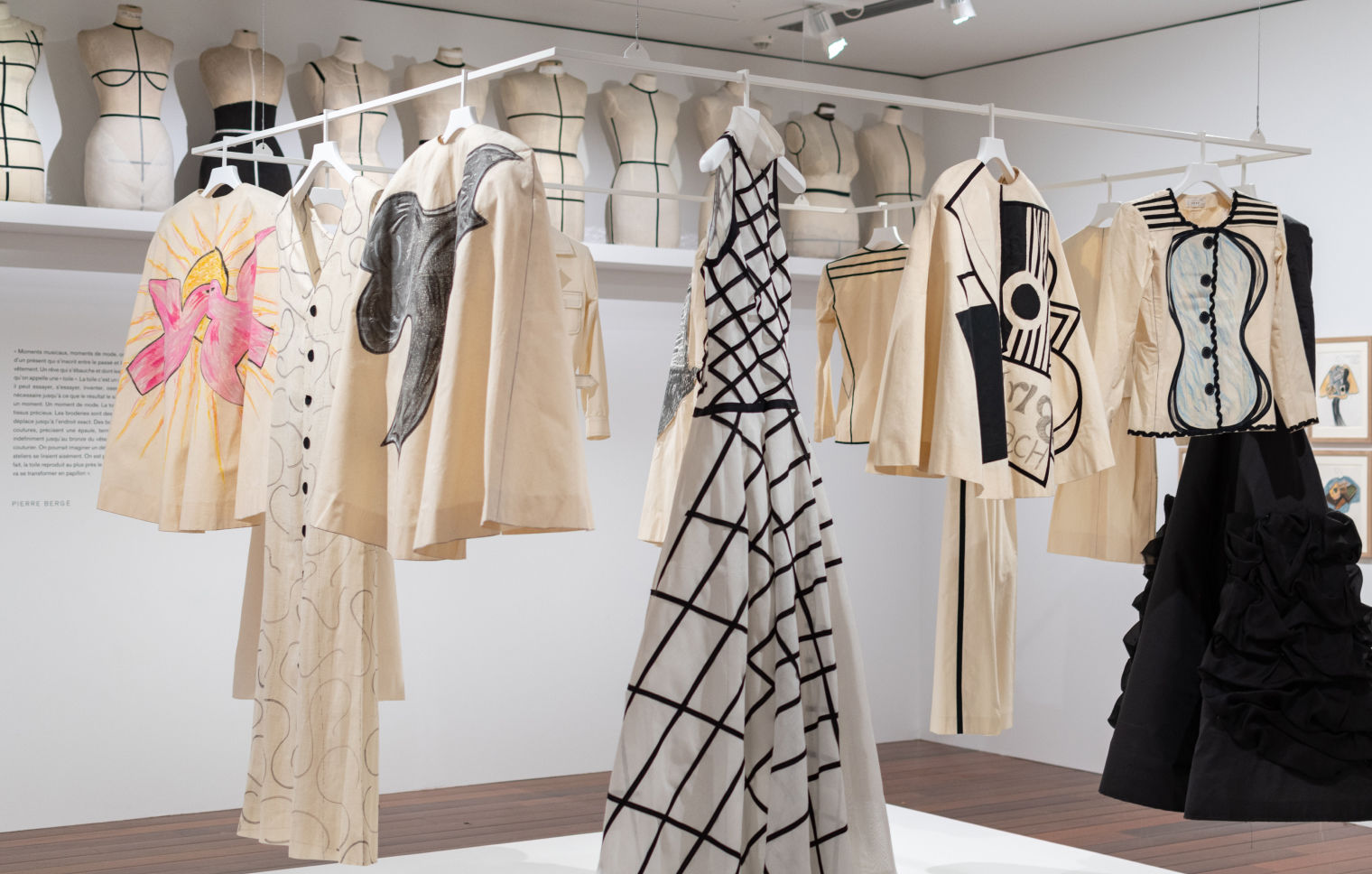Listen to this article
Standing in front of Vincent Van Gogh’s iconic painting Irises (1890) at The Met, I am captivated by the calming qualities of the thick brushstrokes, the flowing lines, and the coolness of the faded violet hues. An interpretation of Van Gogh’s irises then comes to mind, one where the petals are crafted with overlapping sequins and the leaves are demarcated with precise rows of cornflower blue bugle beads.

Yves Saint Laurent (French (born Algeria) Oran 1936–2008 Paris). Ensemble, spring/summer 1988. Silk, glass, metal, pearls. The Metropolitan Museum of Art, New York, Purchase, Friends of The Costume Institute Gifts, 2019 (2019.93a–c)
The piece, a jacket designed by Yves Saint Laurent for his spring–summer 1988 collection, was embellished with pearls, ribbon, and 250,000 sequins in twenty-two colors. It took the Maison Lesage more than six hundred hours to hand embroider the garment. The collection featured an equally detailed jacket inspired by Van Gogh’s sunflowers. It was paired with an emerald-green pencil skirt and modeled by Naomi Campbell under the warm glow of a chandelier on a runway surrounded by cameras.

Yves Saint Laurent spring-summer 1988 runway show. Photograph courtesy of Guy Marineau © Guy Marineau
Three decades later, a Saint Laurent iris jacket was sold at auction for 175,500 euros, while one of four sunflower jackets sold for 382,000 euros. Beyond raising staggering sums at auction, these jackets raise a question: Can Saint Laurent’s designs be considered art, too?
Boundaries often blur in the realm of art. We look at art through a subjective lens—is a piece beautiful or unappealing?—and consider its historical context—was it revolutionary at the time, even if it appears mundane now? What distinguishes art from craftsmanship? How do we determine what qualifies as art, and where does fashion fit on that spectrum? With these questions in mind, I embarked on an exploration of Saint Laurent’s career and history with The Met, while also visiting six exhibitions in Paris that showcased the designer’s work in conversation with art.
Throughout his career, Saint Laurent transported artworks from walls to bodies. This remarkable endeavor began in 1965 when Saint Laurent was reading Michel Seuphor’s book, Piet Mondrian, Life and Work. The purity of Mondrian’s simple lines and color blocks resonated deeply with Saint Laurent, inspiring him to create a collection of twenty-six designs that mirrored the principles of Neoplasticism. With strategic darts and seams, he transformed abstract paintings into three-dimensional cocktail dresses that maintained geometric alignment on the body.

Yves Saint Laurent cocktail dress, homage to Piet Mondrian, autumn-winter 1965. Photograph: TopFoto
An immediate success, the Mondrian collection paved the way for Saint Laurent’s art-inspired garments. Although designers Michèle Rosier, John Kloss, and milliner Sally Victor also employed color blocking on their dresses and hats, it was the Mondrian collection that brought global attention to the designer and the painter.
Having lived in Paris for more than 20 years, Mondrian died as a relatively unknown artist in 1944 in New York. Apart from two posthumous gallery exhibitions and a single lithograph given to the Musée National d’Art Moderne [1], Mondrian’s work was unrepresented in France’s collections. Following the attention generated by Saint Laurent’s collection, Mondrian’s first retrospective took place at the Musée de L’Orangerie in 1969.
While Saint Laurent’s art-inspired garments played a significant role in his career, his legacy extends beyond these artistic homages. He is remembered for defying gender norms with his designs, particularly through trouser suits for women called “Le Smoking.” First presented in 1966, the tuxedo caused outrage. Many deemed it inappropriate for women and that belief led to many hotels and restaurants denying admission to women who chose to wear them. Famously, when New York socialite Nan Kempner was denied admission to La Côte Basque due to her Saint Laurent tuxedo, she removed the pants and defiantly entered the restaurant, wearing the blazer as a mini-dress.

Saint Laurent’s tuxedo known as Le Smokin, autumn-winter 1966. Photograph courtesy of Musée Yves Saint Laurent Paris ©Yves Saint Laurent
In the realm of high fashion, Diana Vreeland, the influential former editor of Vogue and consultant for The Met’s Costume Institute, stood as a towering figure. Initially, Vreeland wasn’t convinced of Yves Saint Laurent’s superlative talent, despite sensing great freshness and style in his debut collection at the House of Dior in 1958. [2]
The young designer’s disregard for the status quo, evident in designs featuring exposed breasts and sheer fabrics, raised eyebrows. He seamlessly drew inspiration from street styles, blurring the lines between the everyday and haute couture. Vreeland remarked, “Yves Saint Laurent has a fifty-fifty deal with the street. Half of the time he is inspired by the street and half of the time the street gets its style from Yves Saint Laurent.” [3]
By 1983, however, Vreeland’s perception had shifted. Having witnessed the designer’s continuous innovation and impact on fashion, she joined the club of those who employed the term “genius” to describe Saint Laurent. For the first time in its forty-six-year history, The Costume Institute presented a solo exhibition dedicated to the work of a living designer, and Vreeland chose Saint Laurent for this prestigious honor. In the exhibition catalogue, she declared, “He is without any question the leader in all fashion today.”

Exhibition views of Yves Saint Laurent: Twenty-Five Years of Design held at The Metropolitan Museum of Art from December 14, 1983 to September 2, 1984.
The exhibition held at The Met showcased one hundred fifty garments set against colorful backdrops, taking viewers on a riveting journey through Saint Laurent’s prolific career. A collision of dreams and reality, the exhibition mixed the lavish with the practical, featuring dresses worn by movie stars alongside tuxedos worn by Saint Laurent’s younger clientele. Among the highlights were a row of Mondrian-inspired dresses, a theatrical cape of ostrich feathers, a beige safari-style jacket, a harlequin dress made of satin patchwork, alluring translucent pieces, and loose unassuming wool peacoats—each piece distinct yet unmistakably Saint Laurent.
This duality in his design practice was often attributed to Saint Laurent’s understanding of the times as well as the desires and needs of his clientele. The French actress Catherine Deneuve, who wore his designs on- and offscreen, wrote in the exhibition catalogue that Saint Laurent created for women leading double lives: “His day clothes help a woman confront the world of strangers. They permit her to go everywhere without drawing unwelcome attention […] In the evening, when a woman chooses to be with those she is fond of, he makes her seductive.”

Yves Saint Laurent and his models at the presentation of Saint Laurent’s autumn-winter 1960 collection at the House of Dior. Photograph: TopFoto
The connection between fashion and art has only strengthened over time as more museums around the world curate and present costume exhibitions. In 2022, Yves Saint Laurent Aux Musées, a simultaneous exhibition hosted at six leading Parisian cultural institutions, showcased Saint Laurent’s talent, creative process, and lifelong fascination with art. At the Centre Pompidou, the Mondrian dresses were displayed alongside the artist’s iconic paintings. Similarly, at the Musée National Picasso-Paris, the Portrait de Nusch Éluard (1937) seemed to come alive when paired with Saint Laurent’s Homage to Pablo Picasso, a playful black-and-blue jacket.

Installation view of Yves Saint Laurent Aux Musées, 2022 at the Musée Picasso Paris. Photograph © Aurola Wedman Alfaro. Left: Pablo Picasso (Spanish, 1881–1973). Portrait de Nusch Éluard, 1937. Oil on canvas, 92 x 65 cm. Musée Picasso-Paris © 2023 Estate of Pablo Picasso / Artists Rights Society (ARS), New York Right: Yves Saint Laurent (French, 1936–2008). Homage to Pablo Picasso jacket, autumn-winter 1979. Blue, black and ivory wool. © Yves Saint Laurent
Saint Laurent’s designs inspired by Marcel Proust’s characters from À la recherche du temps perdu (In Search of Lost Time) were exhibited in the clock room at the Musée d’Orsay. At the Musée du Louvre, a dazzling Gallery of Apollo competed for the public’s attention against Saint Laurent’s gold-embroidered jackets, one of them once worn by Vreeland. The Musée d’Art Moderne de Paris explored the reciprocal relationship between the couturier and modern art, showing how their collection inspired his work, and how he was also a source of inspiration for works like Andy Warhol’s Portraits of Yves Saint Laurent (1972).
Finally, at the Musée Yves Saint Laurent Paris, housed in the designer’s former couture studio, visitors could marvel at one of the sunflower jackets and gain insight into the designer’s creative process. An astonishing number of sketches stood as proof of Saint Laurent’s prolific output. In preparation for his first Dior collection, for instance, he drew six hundred sketches in just fifteen days. Saint Laurent acknowledged that his creations didn’t come without feelings of anguish, “waiting for three weeks out of four for the click that sets my fantasies in motion toward their appointment with the physical world. It doesn’t seem like a gift, but I know it is.” [4]

Installation view of Yves Saint Laurent Aux Musées, 2022 at the Musée Yves Saint Laurent Paris. Toiles (‘muslins’) © Yves Saint Laurent Photograph © Aurola Wedman Alfaro.
Saint Laurent initiated dialogues between art and fashion, and laid the foundation for contemporary brands that continue to create art-inspired looks. Forty years after The Costume Institute presented its retrospective, museums worldwide continue to showcase Saint Laurent’s creations, placing his work alongside the masterpieces that inspired him. Can we then consider Saint Laurent’s work that of an artist? Are his designs on par with fine art?
Saint Laurent did not carry grandiose pretensions; he never likened himself to Van Gogh or Picasso through his interpretation of their works. He was a student of culture and an avid art collector, adorning his home with works by De Chirico, Cézanne, Goya, Picasso, and Mondrian. He emphasized that his homages were the result of a profound admiration of the art form: “I didn’t copy them—who would venture to do that? I wanted to weave connections between the painting and the clothing.” [5]
Integrating art into his designs stemmed from a place of genuine admiration. In a similar vein to how we curate our lives through social media, sharing snapshots of things we love, declarations of our values, and highlights of our travels, Saint Laurent curated his worldview and expressed it through his chosen medium—clothing. His subversion of gender norms resulted in tuxedos for women, his passion for Proust materialized in designs inspired by his characters, and his love for painting found its way into the motifs of his clothing.
“My weapon is the way I look at my times and the art of my times.”
This process was perhaps part of his own learning journey, a means of better understanding the artists Saint Laurent admired by applying their teachings to his own craft. He understood that this was his zone of genius. “My weapon is the way I look at my times and the art of my times,” he wrote in Yves Saint Laurent and Art. He immersed himself in real and imaginary worlds—and from these, he emerged with tangible designs that embodied the essence of wearable art.
Saint Laurent made his designs accessible to a wider clientele through his ready-to-wear line, and the success of his Mondrian dresses led to their replication by mass manufacturers, resulting in abundant inexpensive copies. Whether or not it was his intention, Saint Laurent expanded the reach of artworks beyond the confines of museum walls and into human lives. At the very least, he challenged perceptions by demonstrating that women, irrespective of their race or class, deserved to wear works of art. Saint Laurent’s understanding of women, art, and the zeitgeist played a role in his ability to connect with his audience and craft designs that tapped into their aspirations, presenting them with the extraordinary opportunity to wear something beyond their wildest dreams.

Yves Saint Laurent (French, 1936–2008). ‘Homage to My House’ jacket, spring-summer 1990. Organza embroidered with gold and rock crystal. Photograph courtesy of Guy Marineau © Guy Marineau
Notes
[1] Madison Cox, Stephan Janson, and Mouna Mekouar, eds., Yves Saint Laurent and Art (New York : Thames & Hudson, 2022), 25. Return
[2] Diana Vreeland et al., Yves Saint Laurent. (New York: Metropolitan Museum of Art : Clarkson N. Potter, 1983). Return
[5] Yves Saint Laurent, “Mon Dialogue avec L’Art” in Yves Saint Laurent : Dialogue avec L’Art. (Paris: Fondation Pierre Bergé – Yves Saint Laurent, 2004), 9. Return
